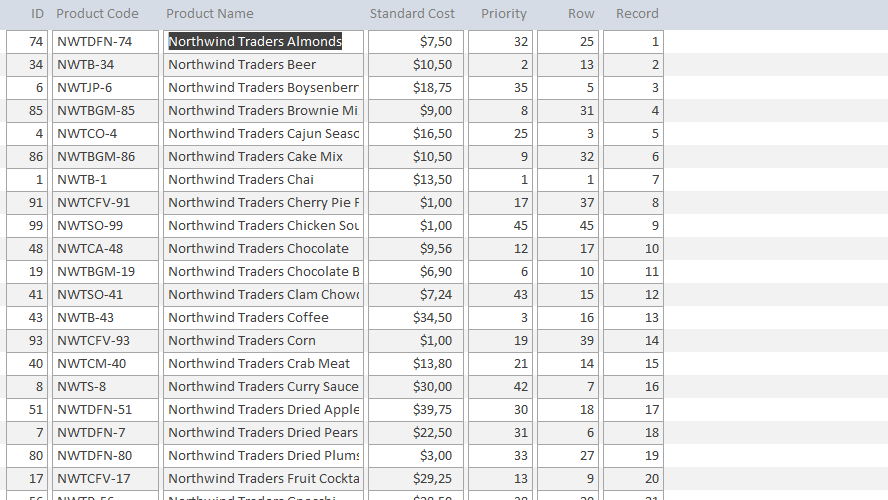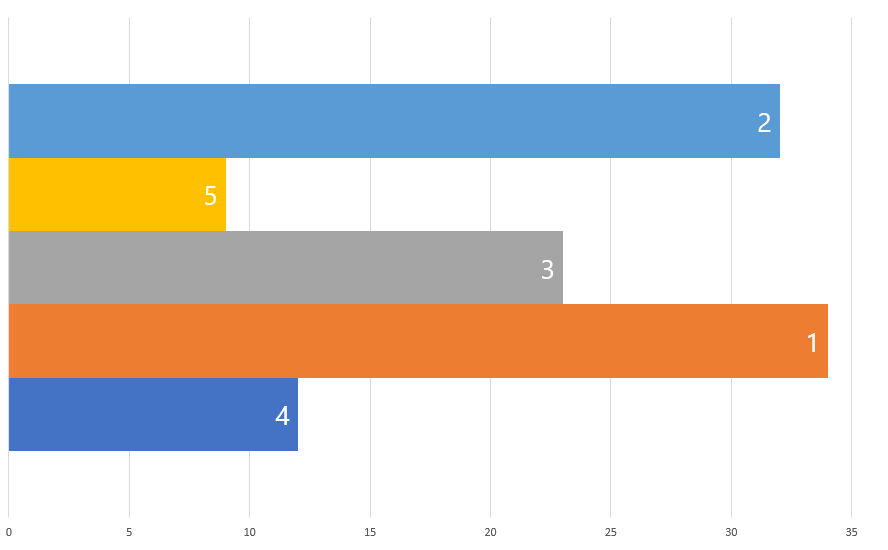Version 1.4.2
(c) Gustav Brock, Cactus Data ApS, CPH
Set of functions to:
- Add a sequential record number to each row in a form
- Add a sequential row number to each record of a query
- Add a sequential user maintained priority number to each record in a form
- Add a random row number to each record of a query
- Add a *rank to each record in a query or a form/report
No third-party tools used, only a single code module that accepts both 32- and 64-bit Microsoft Access.
Further, these traditional and code-less methods are demonstrated:
- Add a sequential row counter to each record of a query or form
- Add a random row number to each record of a query or form
- Add a *rank to each record of a query or form/report
Enumeration can be performed in several ways, but have one thing in common:
A number is assigned each row or record.
The difference is how and when, and - if the records are supposed to be updated, appended, or deleted - by who or what. The numbers can be sequential or random or express a rank.
The functions listed here offer five methods, each having some characteristic advantages and disadvantages:
These are similar to the Record Number displayed in the Navigation Bar of a form (left-bottom, in the status bar of the form).
Advantages
Will always be sequential from top to bottom of the form, no matter how records are ordered, filtered, edited, deleted, or inserted.
For a form, the source can be a table; a query is not required.
Disadvantages
Will not, for the individual record, be static ("sticky").
Belongs to the form, not the recordset.
May update slowly when browsing the form.
For forms only, not queries.
These are created in a query, as a separate field of the resulting recordset.
Advantages
The numbers will not update if records are deleted, and new records will be assigned the next higher number(s) as long as the query is not requeried.
The numbers will be defined by the ordering of the query.
If a form is bound to the query, the numbers will always stick to the individual record, no matter how the form is ordered or filtered, or (if the query or form is not updated/requeried) if records are added or deleted.
Generating the numbers takes one table scan only, thus browsing the query, or a form bound to it, is very fast.
As the numbers are static ("sticky"), they are well suited for export or for use in append queries.
Disadvantages
If records are added or deleted, the assigned numbers may change after a requery to regain sequentiality.
If used in a form, and different filtering or sorting is applied, there is no method to reqain sequentiality other than to revert to the original ordering and remove filtering.
These are stored in a separate numeric field of the table. Thus, they are persistent, and primarily intended to be maintained by a user having the records listed in a form.
Advantages
The numbers will be persistent, no matter how the records are filtered or ordered.
When maintained in a form, a new record will automatically be assigned the next higher number (lowest priority).
In the form, records can be inserted or deleted without breaking the sequentiality of the numbers.
Can easily, for example by a button-click, be reset to match the current sorting of the form.
Will not degrade browsing in any way.
Disadvantages
If records can be inserted or deleted from sources not maintaining the sequentiality of the numbers, this will be broken. However, sequentiality can be restored by a call to the function AlignPriority.
These are pseudo-random numbers assigned each record in a query, as a separate field of the resulting recordset. The typical purpose is to sort on these, selecting a specific (small) count of random records from a (large) recordset.
For this purpose, a query must be used to generate the numbers; if the numbers are generated from an expression bound to the ControlSource of a control in a form, the form will not be able to sort on that field, which in most cases would defeat its purpose.
Advantages
Allows what appears to be a random selection of records.
Allows what appears to be a random ordering of the records.
Very fast. Will not degrade browsing in any way.
In a form, the numbers will not change if sorting or filtering is changed, or the form is requeried.
Can easily, for example by a button-click, be shuffled.
Disadvantages
Must be implemented in a query to be useful.
The principle of ranking is not difficult to understand, but one topic complicates matters: Dupes.
If any two or more of the values are equal, we must have clear guidelines prepared:
- How should the dupes be ranked?
- How should the dupes influence the ranking of the succeeding values?
Ranking values, taken this into account, can be done using any of five common methods also called strategies.
Also, the values to rank can be ordered ascending or descending. The default is descending, meaning that the highest values are assigned the highest (numerically lowest) ranks. However, ascending is also common and is what is used for "smallest is best" measures like time to run 100 m or fuel consumed per distance unit.
While calculating rank with SQL only can be convenient for small recordsets, it may be slow for listing many records because of the subqueries. Thus, the function, RowRank, is using a collection in VBA that will calculate and cache the rank of the records for all five strategies with one table scan only.
The RowRank function supports these five strategies (methods):
| Name | Nick name | Excel equivalent formula |
|---|---|---|
| Standard competition ranking | "1224" ranking | RANK.EQ |
| Modified competition ranking | "1334" ranking | |
| Dense ranking | "1223" ranking | |
| Ordinal ranking | "1234" ranking | |
| Fractional ranking | "1 2.5 2.5 4" ranking | RANK.AVG |
A detailed explanation for each can be found on WikiPedia: Ranking.
This is a simple counter using an expression with DCount that - for each record - counts the records having a unique key equal to the current key or lower.
Advantages
The sequence of the numbers will always be aligned with the ascending order of the unique key referenced.
Requires zero code, only a TextBox having an expression as ControlSource.
In a form, the numbers will not change if sorting or filtering is changed.
Disadvantages
As the number is calculated for each record visible in the form, browsing can be slow, indeed for large recordset.
This is a simple pseudo-random number generator using an expression with Rnd that assigns a pseudo-random number to each record. However, these are delicate and will be regenerated whenever the form or query is requeried, or sorting or filtering is changed.
Advantages
Requires zero code, only a TextBox having an expression as ControlSource.
Can be copy-pasted to, say, Excel.
Disadvantages
Very fragile. Any sorting, filtering, or a requery will rebuild the numbers.
Cannot be sorted in a form.
Advantages
Requires zero code other than SQL.
Disadvantages
SQL expression is convoluted.
Slow for large recordsets.
All code is contained in one module: RowEnumeration
In those cases where a form is used for display of the records, some additional code may be required in the code-behind module of the form. This is, however, kept at a minimum, and is documented in the in-line comments of the functions.
A separate module contains some functions to demonstrate how to call the helper functions for resetting or requerying the number series.
A set of queries and forms are included in the Microsoft Access 2016 project to demonstrate typical implementations of the functions.
Detailed documentation is in-line.
Articles on the topic can be found here:
- Random Rows in Microsoft Access
- Sequential Rows in Microsoft Access
- Ranking Rows in Microsoft Access
If you wish to support my work or need extended support or advice, feel free to:



